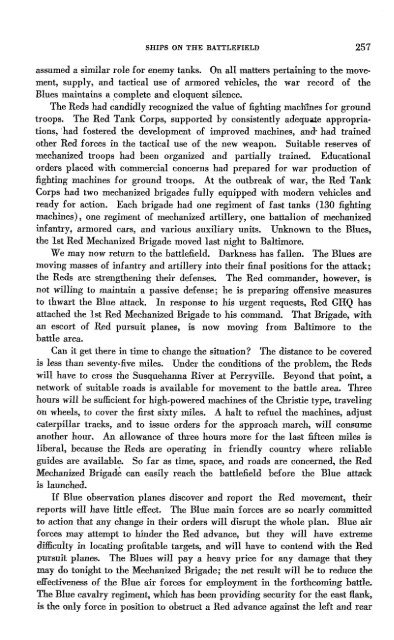THE COAST ARTILLERY JOURNAL - Air Defense Artillery
THE COAST ARTILLERY JOURNAL - Air Defense Artillery
THE COAST ARTILLERY JOURNAL - Air Defense Artillery
Create successful ePaper yourself
Turn your PDF publications into a flip-book with our unique Google optimized e-Paper software.
SHIPS ON <strong>THE</strong> BATTLEFIELD 257<br />
assumed a similar role for enemy tanks. On all matters pertaining to the movement,<br />
supply, and tactical use of armored vehicles, the war record of the<br />
Blues maintains a .complete and eloquent silence.<br />
The Reds had candidly recognized the value of fighting machines for ground<br />
troops. The Red Tank Corps, supported by consistently adequate appropriations,<br />
'had fostered the development of improved machines, and. had trained<br />
other Red forces in the tactical use of the new weapon. Suitable reserves of<br />
mechanized troops had been organized and partially trained. Educational<br />
orders placed with commercial concerns had prepared for war production of<br />
fighting machines for ground troops. At the outbreak of war, the Red Tank<br />
Corps had two mechanized brigades fully equipped with modern vehicles and<br />
ready for action. Each brigade had one regiment of fast tanks (130 fighting<br />
machines), one regiment of mechanized artillery, one battalion of mechanized<br />
infantry, armored cars, and various auxiliary units. Unknown to the Blues,<br />
the 1st Red Mechanized Brigade moved last night to Baltimore.<br />
We may now return to the battlefield. Darkness has fallen. The Blues are<br />
moving masses of infantry and artillery into their final positions for the attack;<br />
the Reds are strengthening their defenses. The Red commander, however, is<br />
not willing to maintain a passive defense; he is preparing offensive measures<br />
to thwart the Blue attack. In response to his urgent requests, Red GHQ has<br />
attached the 1st Red Mechanized Brigade to his command. That Brigade, with<br />
an escort of Red pursuit planes, is now moving from Baltimore to the<br />
battle area.<br />
Can it get there in time to change the situation? The distance to be covered<br />
is less than seventy-five miles. Under the conditions of the problem, the Reds<br />
will have to cross the Susquehanna River at Perryville. Beyond that point, a<br />
network of suitable roads is available for movement to the battle area. Three<br />
hours will be sufficientfor high-powered machines of the Christie type, traveling<br />
on wheels, to cover the first sixty miles. A halt to refuel the machines, adjust<br />
caterpillar tracks, and to issue orders for the approach march, will consume<br />
another hour. An allowance of three hours more for the last fifteen miles is<br />
liberal, because the Reds are operating in friendly country where reliable<br />
guides are available. So far as time, space, and roads are concerned, the Red<br />
Mechanized Brigad~ can easily reach the battlefield before the Blue attack<br />
is launched.<br />
If Blue observation planes discover and report the Red movement, their<br />
reports will have little effect. The Blue main forces are so nearly committed<br />
to action that any change in their orders will disrupt the whole plan. Blue air<br />
forces may attempt to hinder the Red advance, but they will have extreme<br />
difficulty in locating profitable targets, and will have to contend with the Red<br />
pursuit planes. The Blues will pay a heavy price for any damage that they<br />
may do tonight to the Mechanized Brigade; the net result will he to reduce the<br />
effectiveness of the Blue air forces for employment in the forthcoming battle.<br />
The Blue cavalry regiment, which has been providing security for the east flank,<br />
is the only force in position to obstruct a Red advance against the left and rear
















